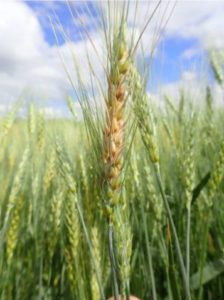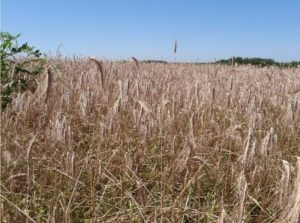Effective and Cost-Saving Management of Diseases in Small Grains
 Albion, Iowa farmer Wade Dooley started adding small grains into his rotation about ten years ago and promptly focused on custom seeding and growing cover crop seed. Throughout that time, he has continued to adapt his rotation to changing climate conditions.
Albion, Iowa farmer Wade Dooley started adding small grains into his rotation about ten years ago and promptly focused on custom seeding and growing cover crop seed. Throughout that time, he has continued to adapt his rotation to changing climate conditions.
Over the years, Wade has learned to manage diseases in his small grain crops, sometimes experiencing devastating loss, and other times successfully mitigating disease pressure.
“I’ve been able to completely change a farm in a single year with a really targeted approach of high diversity and low tillage. But I’m also more willing than a lot of folks to accept risk and I’m more willing to fail.”
Wade offered insights on effectively managing small grains diseases in a small grains shared learning call in April 2024.
Disease Season
“In Central Iowa, because we’re raising a cool season crop that ripens right at the peak of our humidity and heat, there are a ton of diseases that can roll through,” Wade says.
Any farmer that grows rye in the Midwest must be wary of Fusarium head blight, also known as scab. This disease hits when conditions are right and harbors vomitoxin that may reduce germination rates for cover crop seed or make the grain unsafe for animal or human consumption. FHB appears as bleaching of the small grain “flower” and can turn the grain a strange pinkish-purple color.

Bleaching of the flower head due to Fusarium head blight. Image courtesy of CropProtectionNetwork.org.
Timing is key when it comes to managing FHB. Wade says, “Fusarium isn’t an issue before the plant starts flowering. And after everything’s pollinated, it’s not an issue either. It’s only in that critical window of flowering that I worry about Fusarium.”
But he cautions farmers that when signs of FHB appear, it is too late to apply a fungicide. Forward-thinking management decisions must consider weather patterns well in advance of spraying.
Making the Call to Spray
Wade pays close attention to weather conditions throughout the growing season and uses helpful resources to track the potential for Fusarium to crop up. One particularly beneficial resource is the webpage for the U.S. Wheat & Barley Scab Initiative which includes a regularly updated FHB risk map and various reports and videos about challenges and management of the disease. By following this map over time, a farmer can determine how likely it is FHB will become an issue. If that timing lines up with the expected flowering stage for the planted small grain variety, then fungicide should be applied.
According to Wade, the best time to spray fungicide is when about 50% of the field is blooming, usually in early June. Ideally, spray nozzles will point in two directions so that the flower heads will be hit on both sides. Part of the flower head could still show signs of FHB if it is not adequately sprayed.
“Often, the chemical folks at coops don’t stock the right fungicide, so you have to call ahead and ask them to get it in stock a few weeks before you think you might need it. Otherwise, you might miss the window simply because they didn’t have it on the shelf.”
Saving Money Through Judicious Fungicide Use
Fungicide isn’t always needed. Wade notes that he has not had to spray the last few summers, ironically thanks to the drought.
“I know a lot of folks out there that don’t pay attention to conditions, but just listen to their chemical rep who tells them to spray fungicide to get five or ten extra bushels,” Wade says. “So they do it without checking any of the climatic conditions, and often it’s not even worth the extra cost.”
Wade also points out that it is possible to avoid the high-risk FHB window by planting earlier flowering varieties. There are also various small grain varieties bred to be resistant to Fusarium and other diseases.

A VNS (variety not stated) wheat field early in Wade’s foray into small grains. He has since focused on planting disease-resistant varieties and finding cost-efficient methods for weed control.
“My personal favorite thing to do is to pick more resistant varieties and try to manage things from a cultural standpoint, rather than use fungicide as the main fix,” Wade says. “Fungicides kill a whole slew of things and much of what they kill is beneficial.”
When choosing resistant varieties though, it is important to pay attention to where those varieties were bred. Often, more northerly varieties will not resist disease when planted significantly further south. For example, a farmer in southeast Iowa would be better off choosing a variety released by the University of Illinois rather than South Dakota State University.
Other Diseases to Look Out For
Though rye is particularly susceptible to FHB, it experiences less damage from leaf diseases, such as rust, because its stalk photosynthesizes, making the leaves less critical. However, that is not the case for oats and wheat where leaf diseases can dramatically affect yield. There are many different fungicides available to stave off such diseases, but Wade emphasizes, “If you’re going to spray fungicide, you need to do it at the right rate, in the right manner and at the right time.”
Barley Yellow Dwarf Virus (BYDV) is another disease that can become a big issue, especially in barley and oats, because there is no real treatment. Brought in by aphids, it causes leaves to become yellow with reddish-purple tips.
Since aphids target grasses, the best way to manage crops without the use of insecticides is to separate grasses in rotations, minimize weeds on field edges, and try to find varieties that are more resistant to BYDV.
Additional Resources
For Scab/Blight info: U.S. Wheat and Barley Scab Initiative
2019 PFI blog post: How to Manage Small Grain Diseases While Maintaining the Bottom Line
Sign up for PFI’s monthly Small Grains News email newsletter to receive program updates, small grains resources and information on upcoming events.
Register for our upcoming small grains shared learning calls via Zoom.
Learn about and apply for our small grains cost-share program.
Acknowledgements
This material is based upon work supported by the U.S. Department of Agriculture and National Fish and Wildlife Foundation, under grant ID 2004.22.075401 and agreement number 75401.
Any opinions, findings, conclusions, or recommendations expressed in this publication are those of the author(s) and do not necessarily reflect the views of the U.S. Department of Agriculture. In addition, any reference to specific grants or types of products or services does not constitute or
imply an endorsement by the U.S. Department of Agriculture for those products or services.
The views and conclusions contained in this document are those of the authors and should not be interpreted as representing the opinions or policies of the U.S. Government or the National Fish and Wildlife Foundation and its funding sources. Mention of trade names or commercial products does not constitute their endorsement by the U.S. Government, or the National Fish and Wildlife Foundation or its funding sources.
